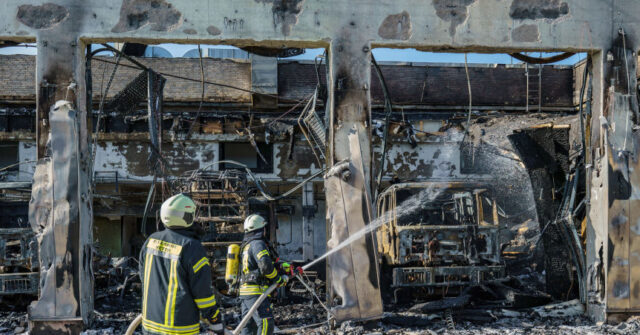A catastrophic fire has resulted in the destruction of a newly built fire station and nearly a dozen fire engines in Stadtallendorf, Hessen, Germany. The blaze occurred in the early hours of Wednesday morning and caused an estimated loss of up to €24 million ($26 million). This facility, which had been officially opened less than a year prior, housed ten fire engines, including a state-of-the-art “disaster relief logistics vehicle” intended for use in emergencies like forest fires and floods. Unfortunately, the fire station was devoid of a functional fire alarm system or sprinklers, features that are not mandated by German law for such buildings.
Investigators from the Hessen state criminal police are currently probing the circumstances surrounding the fire’s ignition, with findings expected next week. According to reports from local media citing police sources, the fire may have originated from one of the vehicles parked inside, potentially linked to a malfunctioning battery charger. This incident raises critical questions about safety protocols, particularly in facilities dedicated to firefighting. Fire brigades play a dual role in both extinguishing fires and advocating for fire prevention, underscoring the importance of smoke alarms in residential spaces. The absence of a fire alarm or sprinkler system in a modern fire station is not only ironic but alarming given the context.
Norbert Fischer, the President of the Hesse State Fire Brigade Association, weighed in on the issue, emphasizing the need for fire alarm systems in fire stations where battery charging occurs regularly. He highlighted the presence of advanced technology within the station, which increases fire risk and suggests that fire prevention measures should be prioritized. Nevertheless, he expressed skepticism about whether an alarm system would have mitigated the disaster, given the rapid spread of the fire, which he described as swift and overwhelming.
District fire inspector Lars Schäfer described fighting a fire at a fire station as a “worst-nightmare scenario” for firefighters. He articulated the challenge of having to put out a blaze in their own workplace, emphasizing the emotional and psychological toll it takes on emergency responders. In terms of response, the building and equipment were insured, which offers some financial relief for the losses incurred. The Stadtallendorf fire brigade has managed to secure fire engines from neighboring stations to maintain local emergency services while they work toward acquiring replacements for their lost vehicles.
In the interim, the fire brigade will temporarily operate from their previous accommodation, allowing them to effectively manage local coverage despite the devastating loss of their newly constructed facility. The incident serves as a poignant reminder of the inherent risks involved in firefighting and the critical need for stringent safety measures in all related buildings. Furthermore, it raises important discussions around the necessity of fire detection and suppression systems, even in facilities that are primarily tasked with managing fire emergencies.
As the investigation unfolds, the community and fire services alike are left reflecting on this tragedy while grappling with both the operational and financial implications of such a devastating loss. The Stadtallendorf fire station had been a symbol of modern firefighting capabilities, and its destruction not only impacts emergency response efforts but also serves as a testament to the potential vulnerabilities that exist even within well-equipped facilities. The hope is that this incident will prompt a reevaluation of safety regulations and lead to improved measures to prevent similar occurrences in the future, ensuring that fire stations can fulfill their mission without falling victim to the very dangers they are trained to combat.

